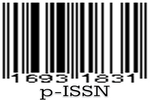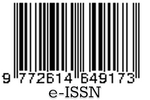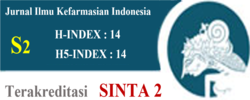Green synthesis of silver nanoparticles using Pluchea (Pluchea indica (L.)) leaf extract and antibacterial activity against Staphylococcus aureus and Propionibacterium acnes
Abstract
Nanotechnology is widely used in the biomedical purpose as a drug delivery system, cancer, and tumor biomarkers. Currently, metals are most used as precursor agents to form nanoparticles such as silver, gold, iron, zinc, and metal oxides. Acne is one of the skin problems caused by the growth of S. aureus and P. acnes bacteria. Treatment of acne using inappropriate antibiotics can lead to resistance. Silver nanoparticles are known to have the ability to kill pathogenic microorganisms. Pluchea leaf extract contains flavonoid, polyphenol, and tannin compounds that can work as natural bioreductors in the formation of silver nanoparticles while inhibiting bacterial growth. This study aims to synthesize silver nanoparticles using Pluchea leaf extract and testing antibacterial activity against Staphylococcus aureus and Propionibacterium acnes. Extraction of Pluchea leaves was carried out using the infusion method with the water solvent. The synthesis of silver nanoparticles was used a shaker incubator at a speed of 150 rpm and a temperature of 37 ºC for 48 hours. Characterization of silver nanoparticles using uv-vis spectrophotometry, particle size analyzer (PSA), zeta potential analyzer, and FESEM-EDX. Antibacterial activity test using microdilution method. The characterization results of silver nanoparticles showed a particle size of 20.50 nm, a zeta potential of -38.6 mV, and a spherical morphological shape. Silver nanoparticles have antibacterial activity against S. aureus and P. acnes with a Minimum Inhibitory Concentration (MIC) value of 62.5 ppm and Minimum Bactericidal Concentration (MBC) value >250 ppm.
References
[2] N. A. T. Nisa, D. E. Pratiwi, and M. Maryono, "The effect of poly vinyl alcohol addition on the characteristics of silver nanoparticles synthesis using bioreductor Moringa oleifera extract," Jurnal Chemica, vol. 21, no. 2, pp. 173–183, Dec. 2020.
[3] E. Rohaeti and Senam, “Development of antibacterial cotton fibers by application nanoparticle produced by mangosteen rind,” Rasayan Journal of Chemistry, vol. 14, no. 1, pp. 382–388, 2021, doi: 10.31788/RJC.2021.1416034.
[4] L. L. Sofidiana, E. Sulistyani, and P. E. Lestari, “Identification of saponin and antioxidant activity from lamun leaf extract (Thalassia hemprichii),” Journal of Pharmacy Science and Practice, vol. 4, no. 2, pp. 56–65, 2020.
[5] S. Sambhudevan and A. V. Vidyapeetham, “Green synthesis of silver nanomaterials.” [Online]. Available: https://www.researchgate.net/publication/355753118
[6] W. Amiani, M. Ricko Fahrizal, and R. Nathasya Aprelea, “kandungan metabolit sekunder dan aktivitas tanaman bajakah sebagai agen antioksidan,” Jurnal Health Sains, vol. 3, no. 4, pp. 516–522, Apr. 2022, doi: 10.46799/jhs.v3i4.461.
[7] V. Ravichandran, S. Vasanthi, S. Shalini, S. A. A. Shah, M. Tripathy, and N. Paliwal, “Green synthesis, characterization, antibacterial, antioxidant and photocatalytic activity of Parkia speciosa leaves extract mediated silver nanoparticles,” Results Phys, vol. 15, Dec. 2019, doi: 10.1016/j.rinp.2019.102565.
[8] C. Sowmya, V. Lavakumar, N. Venkateshan, V. Ravichandiran, and D. V. R. Saigopal, “Exploration of Phyllanthus acidus mediated silver nanoparticles and its activity against infectious bacterial pathogen,” Chem Cent J, vol. 12, no. 1, 2018, doi: 10.1186/s13065-018-0412-7.
[9] G. N. Rajivgandhi et al., “Photocatalytic reduction and anti-bacterial activity of biosynthesized silver nanoparticles against multi drug resistant Staphylococcus saprophyticus BDUMS 5 (MN310601),” Materials Science and Engineering C, vol. 114, Sep. 2020, doi: 10.1016/j.msec.2020.111024.
[10] P. Sathishkumar et al., “Anti-acne, anti-dandruff and anti-breast cancer efficacy of green synthesised silver nanoparticles using Coriandrum sativum leaf extract,” J Photochem Photobiol B, vol. 163, pp. 69–76, Oct. 2016, doi: 10.1016/j.jphotobiol.2016.08.005.
[11] L. Ge, Q. Li, M. Wang, J. Ouyang, X. Li, and M. M. Q. Xing, “Nanosilver particles in medical applications: Synthesis, performance, and toxicity,” May 16, 2014, Dove Medical Press Ltd. doi: 10.2147/IJN.S55015.
[12] L. Retno Sari and P. Studi Pendidikan Kimia Jurusan PMIPA FKIP, “Ujı efektıfıtas asap caır cangkang buah karet (Hevea braziliensis) sebagaı antıbakterı Bacillus subtilis,” vol. 3, no. 1, pp. 34–40, 2019.
[13] I. Donowarti and F. Dayang Diah, “Pengamatan hasil olahan daun Pluchea (Pluchea indica L.) terhadap sifat fisika dan kimianya,” Teknologi Pangan : Media Informasi dan Komunikasi Ilmiah Teknologi Pertanian, vol. 11, no. 2, pp. 118–134, Aug. 2020, doi: 10.35891/tp.v11i2.2166.
[14] A. R. Hafsari et al., “Ujı aktıvıtas antıbakterı ekstrak daun pluchea ( Pluchea indica (L.) LESS. ) terhadap propionibacterium acnes penyebab jerawat,” vol. IX, no. 1, 2015.
[15] A. R. Zabidi, M. A. Mohd Razif, S. N. Ismail, M. W. Sempo, and N. Yahaya, “Antimicrobial and antioxidant activities in ‘Pluchea’ (Pluchea indica), turmeric (Curcuma longa) and their mixtures,” Sains Malays, vol. 49, no. 6, pp. 1293–1302, Jun. 2020, doi: 10.17576/jsm-2020-4906-07.
[16] H. Zahrah, A. Mustika, and K. Debora, “Antibacteri activity and morphological changes of Propionibacterium acnes after giving curcuma xanthorrhiza extract,” Jurnal Biosains Pascasarjana, vol. 12, no. 1, 2019.
[17] W. Wahab and A. Karim, “Synthesıs of sılver nanopartıcles usıng pluchea leaf (Pluchea Indica L.) extract,” 2019.
[18] L. Mulqie et al., “aktıvıtas antıbakterı ekstrak etanol daun jambu aır [Eugenia aqueum (Burm. F) alston] dengan mıkrodılusı agar,” Jurnal Ilmiah Farmasi Farmasyifa, vol. 5, no. 1, pp. 1–8, Feb. 2022, doi: 10.29313/jiff.v5i1.7849.
[19] R. I. , Fajar, L. P. , Wrasiati, and L. Suhendra, “Flavonoid and antibactery activity of green tea leaf extract at variation of temperature and times brewing,” Jurnal Rekayasa Dan Manajemen Agroindustri, vol. 6, no. 3, p. 196, 2018.
[20] I. Ristian, S. Wahyuni, D. Kasmadi, and I. Supardi, “Study of effect silver nanoparticles concentration on particles size of silver nanoparticle,” Indonesian Journal of Chemical Science, vol. 3, no. 1, pp. 8–11, 2014.
[21] A. , Sirajudin and S. Rahmanisa, “Silver nanoparticles in urinary tract ınfection management,” Majority, vol. 5, no. 4, pp. 1–5, 2016.
[22] N. Willian et al., “Revıew bıofabrıcatıon of sılver and gold nanopartıcles usıng plants extract,” Jurnal Zarah, vol. 9, no. 1, pp. 42–53, 2021.
[23] S. K. Srikar, D. D. Giri, D. B. Pal, P. K. Mishra, and S. N. Upadhyay, “Green synthesis of silver nanoparticles: a review,” Green Sustain. Chem, vol. 6, pp. 34–56, 2016.
[24] V. A. Fabiani and R. Lingga, “Green synthesis of silver nanoparticles via Cratoxylum glaucum leaf extract
loaded polyvinyl alcohol and ıts antibacterial acitvity,” JKPK (Jurnal Kimia dan Pendidikan Kimia), vol. 7, no. 3, p. 314, Dec. 2022, doi: 10.20961/jkpk.v7i3.64719.
[25] M. D. Purnamasari, Harjono, and N. Wijayati, “Synthesis of silver nanoparticles using bioreductor betel leaf with ırradiation microwafe method,” Indonesian Journal of Chemical Science, vol. 5, no. 2, pp. 152–158, 2016.
[26] R. N. Ridwan, G. Gusrizal, N. Nurlina, and S. J. Santosa, “synthesis and stability study of silver nanoparticles coated salysilic acid,” Indonesian Journal of Pure and Applied Chemistry , vol. 1, no. 3, pp. 83–90, 2011.
[27] R. Jannah and A. Amaria, “Article review : Synthesis of silver nanoparticles using amino acid reducers as detection of heavy metal ıons,” in Prosiding Seminar Nasional Kimia (SNK), Surabaya, Nov. 2020, pp. 185–202.
[28] T. Prasetyaningtyas, A. T. Prasetya, and N. Widiarti, “Silver nanoparticles modified chitosan using basil leaf extract (Ocimum Basilicum L.) and antibactery acitivity,” Indonesian Journal of Chemical Science, vol. 9, no. 1, pp. 37–43, 2027.
[29] M. Prihantini, E. Zulfa, D. Listyana, I. Prastiwi, and Y. Dyah, “Pengaruh waktu ultrasonıkası terhadap karakterıstık fısıka nanopartıkel kıtosan ekstrak etanol daun sujı (Pleomele angustifolia) dan ujı stabılıtas fısıka menggunakan metode cyclıng test,” 2019. [Online]. Available:
www.unwahas.ac.id/publikasiilmiah/index.php/ilmufarmasidanfarmasiklinik
[30] Murdock, Richard C, and Stolle, “Characterization of nanomaterial dispersion in solution prior to in vitro exposure using dynamic light scaterring technique,” Toxicol Sci, vol. 101, no. 2, pp. 239–253, 2008.
[31] M. Abdassah, “Nanoparticles with ıonic gelation,” Farmaka, vol. 15, no. 1, pp. 45–52, 2017.
[32] C. Ariani Edityaningrum, A. T. Oktafiani, L. Widiyastuti, and D. A. Arimurni2, “Formulation and evaluation of silver nanoparticles gel,” 2022. [Online]. Available: http://jurnal.unpad.ac.id/ijpst/
[33] A. L. Prasetiowati et al., “Indonesian journal of chemical science sintesis nanopartikel perak dengan bioreduktor ekstrak daun belimbing wuluh (Averrhoa Bilimbi L.) sebagai antibakteri,” 2018. [Online]. Available: http://journal.unnes.ac.id/sju/index.php/ijcs
[34] Setyaningsih, Natalia Erna., R. utaqqin, and Isna. Mar’ah, “optimalization of coating time on composite materials for morphological characterization using scanning elctron miscroscope (SEM)- energy dispersive X-Ray spectroscopy (EDX),” Physics Communication, vol. 1, no. 2, pp. 36–40, 2017.
[35] S. Bhakya, S. Muthukrishnan, M. Sukumaran, and M. Muthukumar, “Biogenic synthesis of silver nanoparticles and their antioxidant and antibacterial activity,” Applied Nanoscience (Switzerland), vol. 6, no. 5, pp. 755–766, Jun. 2016, doi: 10.1007/s13204-015-0473-z.
[36] K. Anandalakshmi, J. Venugobal, and V. Ramasamy, “Characterization of silver nanoparticles by green synthesis method using Pedalium murex leaf extract and their antibacterial activity,” Applied Nanoscience (Switzerland), vol. 6, no. 3, pp. 399–408, Mar. 2016, doi: 10.1007/s13204-015-0449-z.
[37] S. Javan bakht Dalir, H. Djahaniani, F. Nabati, and M. Hekmati, “Characterization and the evaluation of antimicrobial activities of silver nanoparticles biosynthesized from Carya illinoinensis leaf extract,” Heliyon, vol. 6, no. 3, Mar. 2020, doi: 10.1016/j.heliyon.2020.e03624.
[38] A. Miri, N. Dorani, M. Darroudi, and M. Sarani, “Green synthesis of silver nanoparticles using Salvadora persica L. and its antibacterial activity,” Cell Mol Biol, vol. 62, no. 9, pp. 46–50, 2016, doi: 10.14715/cmb/2016.62.9.8.
[39] H. Veisi, S. Hemmati, H. Shirvani, and H. Veisi, “Green synthesis and characterization of monodispersed silver nanoparticles obtained using oak fruit bark extract and their antibacterial activity,” Appl Organomet Chem, vol. 30, no. 6, pp. 387–391, Jun. 2016, doi: 10.1002/aoc.3444.
[40] G. Tailor, B. L. Yadav, J. Chaudhary, M. Joshi, and C. Suvalka, “Green synthesis of silver nanoparticles using Ocimum canum and their anti-bacterial activity,” Biochem Biophys Rep, vol. 24, Dec. 2020, doi: 10.1016/j.bbrep.2020.100848.

This work is licensed under a Creative Commons Attribution-NonCommercial-ShareAlike 4.0 International License.
Licencing
All articles in Jurnal Ilmu Kefarmasian Indonesia are an open-access article, distributed under the terms of the Creative Commons Attribution-NonCommercial-ShareAlike 4.0 International License which permits unrestricted non-commercial used, distribution and reproduction in any medium.
This licence applies to Author(s) and Public Reader means that the users mays :
- SHARE:
copy and redistribute the article in any medium or format - ADAPT:
remix, transform, and build upon the article (eg.: to produce a new research work and, possibly, a new publication) - ALIKE:
If you remix, transform, or build upon the article, you must distribute your contributions under the same license as the original. - NO ADDITIONAL RESTRICTIONS:
You may not apply legal terms or technological measures that legally restrict others from doing anything the license permits.
It does however mean that when you use it you must:
- ATTRIBUTION: You must give appropriate credit to both the Author(s) and the journal, provide a link to the license, and indicate if changes were made. You may do so in any reasonable manner, but not in any way that suggests the licensor endorses you or your use.
You may not:
- NONCOMMERCIAL: You may not use the article for commercial purposes.
This work is licensed under a Creative Commons Attribution-NonCommercial-ShareAlike 4.0 International License.




 Tools
Tools





















